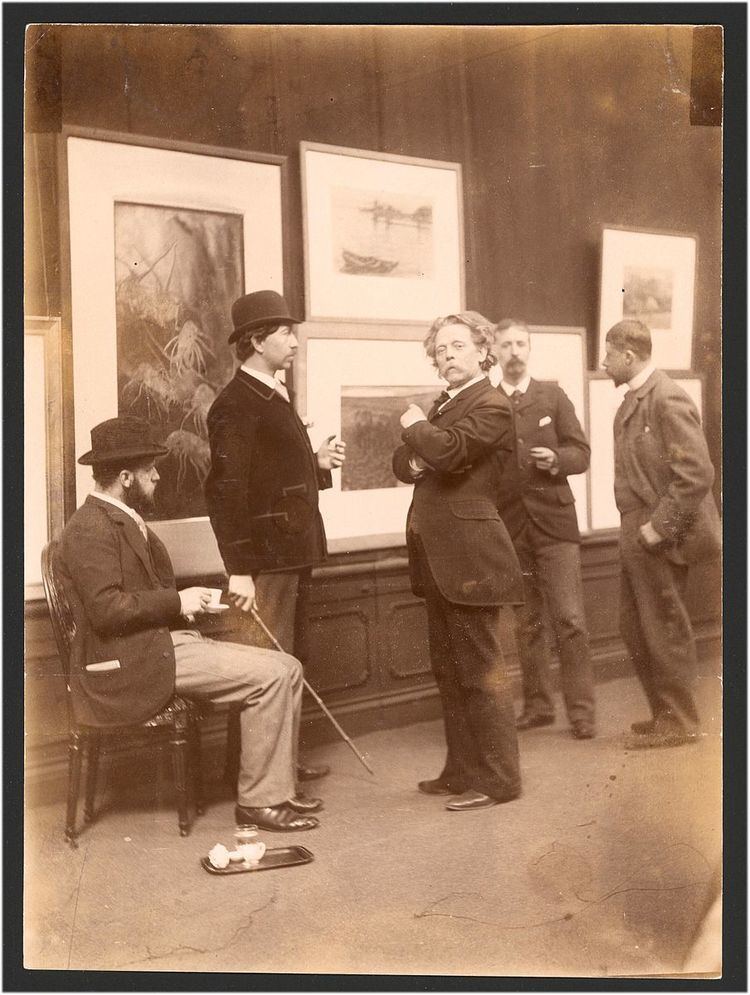 | ||
Willink van Collenprijs (English: The Willink van Collen Award) is a former Dutch art award, which was awarded for the first time in 1880 by the Sociëteit Arti et Amicitiae. It was intended as an encouragement award for young artists, and was considered as a national counterpart to the Paris Salon. Its existence of more than 71 years proves the success of Amsterdam's art policy. For many of its winners, it was a valuable boost to their careers in the Dutch art world. Some of the prize winners were also recognized abroad and remain well known today.
Contents
Background
During the "Second Golden Age of Dutch painting", the Dutch painters enjoyed considerable arts patronage from the upper class. This can also be seen in the context of the Hague School and the School of Allebé.
The Amsterdam-born painter Wilhem Ferdinand Willink van Collen (1847–1881) and his wife Anna Weber-van Bosse were great art lovers. After his death, he bequeathed a sum of 30,000 guilders to the society Arti et Amicitiae to set up a trust fund. The aim was to support young artists' income during their difficult initial phase. This also happened at painter's schools like Düsseldorf painter's School[a], Copenhagen School[b], Weimar Saxon-Grand Ducal Art School[c], the Munich School[d], Academy of Beaux-Arts to Paris[e], Accademia di Belle Arti di Firenze[f] as well as the Barbizon School[g] and the new French Impressionism[h] to give a chance to the Dutch young generation, too.
The annual art exhibition of the Paris Salon was the most important event, too. It was the centre of the painters of Europe and it was very difficult to be allowed to exhibit there. The Five prizes awarded there were highly desired. It concerned two Gold Medals (medals of the 1st class) and three Silver Medals (medals of the 2nd class). Moreover, "Recognitions" and "Honorable Mentions" were pronounced. All this needed an answer in the Netherlands.
The board of Directors of the Association “Arti et Amiticitae” decided to hold an annual painting competition for all Dutch artists. Participants were required to reside in the Netherlands, and be under the age of 30. Later, the age limit was raised to 35. The paintings were submitted unsigned, and evaluated by the jury anonymously. Originally, there was a first place, a second place and a third one, a commendation - structured like the prizes of the Paris Salon. Not every prize was awarded every year. This approach was maintained until 1893. The jury had to deal with a problem of a special kind. The standard of entries was quite staggering. In 1891 it was decided to select a more difficult theme, to deter painters with inadequate training.
The following year, the jury decided to award no first prize. The reason was: It was felt that "no sufficient artistic value" was presented in the submitted works.
No award and its consequences
In 1893, a competition to design a mural for the organizers' building was announced. Only seven submissions were received, all of which disappointed the jury. For the first time in the history of the award, neither the prize nor the commendation were awarded. In 1894, the executive board decided to proceed differently. Instead of awarding the prize, the award money was spent on acquiring the painting “The Snow” by George Hendrik Breitner, a study trip for three Rijksacademie of Amsterdam students, and a small scholarship for Dutch artists living in London.
This decision upset both painters and the general public. This must be seen in the contemporary social context, because the Willink van Collenprijs had become a national institution. As a consequence, a petition to protest this practice was signed by 29 artists, including famous names like Hendrik Willem Mesdag, the brothers Jacob and Willem Maris, Paul Gabriël and Louis Apol. Giving in to the pressure, a competition was organized again in 1896. According to the new rules, there would only be a first prize, and no other places. In the years 1897, 1906, 1909 and 1910, multiple "first prizes" were awarded.
Because of political events, the award could not be written out consistenty. After 71 years, it was awarded for the last time in 1950.
Some themes
Selected topics were expressed
